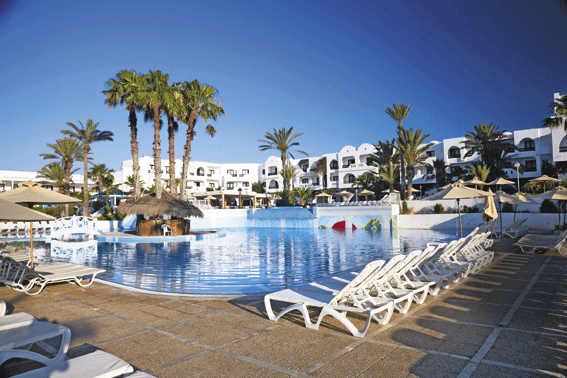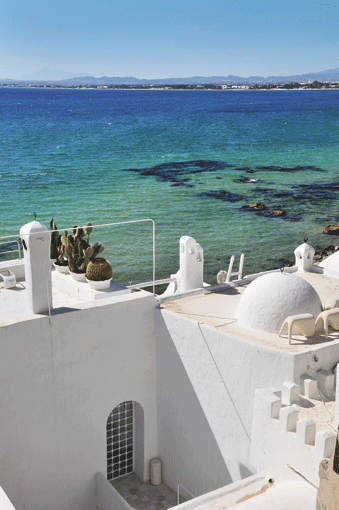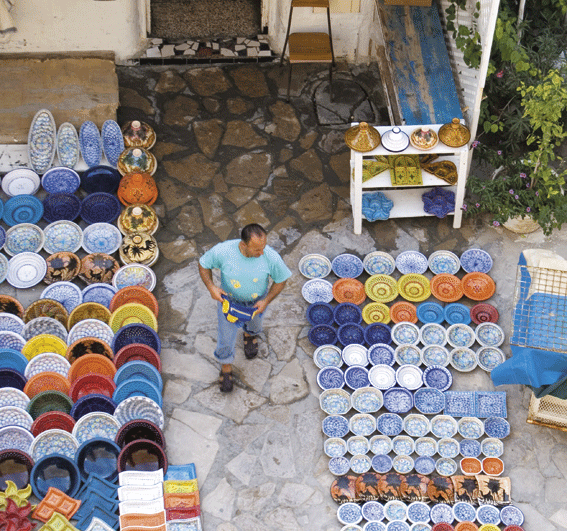

Hammamet
Gateway To Cap Bon
 |
To the Romans Cap Bon was Pulchri Promontorium
(the beautiful peninsula) and the honorific still applies today. Rocky hills and seemingly endless white sand beaches mark this fertile thumb of land which lies only 140 km from Sicily.
While the area has long had close links to Europe, a walk through the blue medina of Hammamet will leave you in no doubt that this is indeed the Arab world. And Hammamet is indeed the jewel in the crown. With a landscape beyond the town of citrus groves and rolling green fields the area is known as the Garden of Tunisia.
By Veronica Maria Garbutt
Historically the almost 3,000 sq km peninsula has been somewhat peripheral to the main events that were played out between the northern and eastern coastal regions. Even today it remains something of a backwater. Its long term inhabitation is based on the fertility of the hinterland which is so intensively planted with olive groves that the shoreline between Nabeul and Hammamet is known as the Olive Coast. Along the southeasten coast Korba is noted for strawberry growing and Nabeul produces harissa, a spicy chilli paste which is an essential ingredient in Tunisian cookery.
Most of Tunisia’s citrus fruit is grown in the southwestern part of Cap Bon around Menzel Bouzelfa. Running down the centre of the peninsula is a line of hills between Jebel Sidi Aderrahman in the east and Jebel Ben Oulid in the west. Most of the Cap’s population of around 5,000 can be found along the southeast coast.
Hammamet
Located 65km from Tunis, Hammamet is easily accessible by public transport – bus, louage (shared taxi) and train. Whitewashed houses with blue shuttered windows abound here with flowers tumbling over garden walls. Although it is now a sprawling urban area , traces of the old town have survived mass development.
Hammamet ( ‘the baths’ ) in Arabic is the country’s busiest resort. In the 1930s European visitors discovered a tiny medina with the Mediterranean lapping at its walls. Fishermen hauled their boats onto fine sand. And a microclimate meant that families had shady orchards beside their houses. The Europeans built their homes with cool vaulted rooms and styled gardens with plunge pools, cypress and orange trees. The first hotels were built along these lines and early planning constraints meant no properties should rise above the treeline.
There are four main resort areas in the town: the medina (hotels include Bellevue, Yasmina, and Bel Azur), M’rezga (Omar Khayam), Zone Touristique Nord ( Les Orangers and Le Miramar), and the new Hammamet Jasmine to the south (Royal Hammamet, Saphir Palace). The latter area boasts many attractions including Carthage Land amusement park, a thalassotherapy spa and a golf course. Inexpensive taxis are probably the best way to get around but there are also buses and a fun train.
To the Romans Hammamet was known as Pupput and their settlement was a few kilometers southwest of today’s town centre. It was a stopping point on the Roman road which linked Hadrometum (modern Sousse) with Carthage. A wealthy patron, Salvius Julianus, expanded agriculture and maritime trade. Later arrivals included the Ottomans, Spanish and Sicilians. If you have an interest in archaeology it is worth visiting the site to view the wall-mounted Byzantine mosaics, wall mosaics and some columns from the 5th century CE House of Figured Peristyle.
Built by the Hasfids on the headland that separates the beach areas into north and south Hammamet, the medina utilizes the site of a former Aghlabid structure. In the northwest corner the Kasbah has fortifications which signify the town’s defensive past. Here on the ramparts you will find a small café along with grest views over the shoreline and web-like medina. The first few streets outside the area offer souvenir stalls, along with clothing and accessories shops. Fortunately the atmosphere is fun and not at all pushy. Continue further and you will find whitewashed houses in quiet alleyways.
The restored 15th century CE minaret of the Great Mosque is a good landmark when you are exploring the medina. At ground level the white mosque walls are dotted with light from wooden doors set in a stone surround. Opposite look out for the green and white striped doors of the public Turkish Baths. Nearby Dar Hammamet Museum of Traditional Dress showcases women’s costumes and wedding dresses.
In the modern town the two main streets are Avenue Habib Bourgiba which runs north from the medina and links up with the road to Hammamet Sud, and Avenue de la Republique which heads northeast from the medina to North Hammamet. This is the commercial centre bursting with shops and restaurants. Every night it has a carnival atmosphere. Check out L’Angolo Verde, a restaurant with some shaded alfresco seating. It serves good pizza and pasta and next door there is an ice cream parlour. For seafood and couscous try La Medina where you can dine on the terrace overlooking the medina, beach and the seafront. And set in a garden offering traditional Tunisian cuisine El Hama Mia can be found on Avenue de Koweit.
Hammamet>s enchanting cultural centre was built by the Romanian billionaire Georges Sebastian in the 1920s. Architect Frank Lloyd Wright said of the villa, «It is the most beautiful house I know.» During the epoch it became a fashionable place and writer Andre Gide and painter Paul Klee were entertained here, amongst other illustrious names. The gardens are a delight to explore and contain a Roman amphitheatre. During July and August it is used to host the town>s International Cultural Festival which features Arabic music, dance and theatre.
Activities and sports
And what to do in Hammamet? If you are fit and active there is diving along with PADI courses at the Samira Club Venus and Port Jasmine Diving Centre. Golf is also popular with two clubs to the west of town. Yasmine has an 18-hole course and a nine hole course for beginners. Citrus, laid out among olive groves and lemon trees has two top knotch 18-hole courses and an easier nine hole course. For riders Club Equestre el Mrezgua offers camel and horseback riding in the surrounding hills. And if you are in need of some serious pampering or looking for a treatment for rheumatism or arthritis check out the thalassotherapy centres of bio Azur of the grounds of Hotel Bel Azur or the vast spa at Hotel Amilcar in Hammamet Sud.
Tour in seven hours
A circular tour from Hammamet to Cap Bon and back, with stops at places of interest en route, takes about seven hours. First up is Nabeul which is the administrative base of the region as well as a pottery, stonecarving and manufacturing centre. Things to do in town include visiting the Friday market (glass, leather, jewellery and ceramics) and studying Cap Bon>s history (Punic jewellery, statues from Thinissut, info on Roman Napolis) at Nabeul Museum on Avenue Habib Bourgiba opposite the railway station. And don>t miss visiting a pottery such as Maison de L>Artisanat, there to see the craftsmen at work.
Some 20 kilometres northeast of Nabeul lies the small town of Korba, noted for its Sunday Market and strawberry and tomato growing. It was the site of the ancient city Julia Kurubis, although the remains are scant – only traces of a viaduct. From the Islamic era are the ruins of the mausoleum of Sidi Maouia and a small ribat designed to protect against pirate attack. The main road to our next stop – Kelibia – runs parallel to Korba lagoon, one of the finest bird watching areas of Tunisia. In winter it offers the stunning spectacle of pink flamingoes amassing on the water.
Upon reaching Kelibia follow the signs to ‘Port’ and ‘Plage’ until you arrive at a massive polygonal fort. Built by the Carthaginians in the 3rd century BCE, the fort offers fantastic views from its ramparts. It is open 0800 – 1800 and you can climb down an iron rung ladder to five interconnecting cells below. Scary! Otherwise Kelibia offers a seemingly endless sandy beach and survives mainly on farming and fishing. The developers and tourists have not yet appeared on the scene.
Discovered only in 1952 the Carthaginian site of Kerkouane gives an insight into the lifestyle of the people who lived here in the 4th century BCE. Set on the edge of a low cliff overlooking the Mediterranean, backed by a hinterland of pines and, the place makes a fine picnic spot. In the ruins of thehouses that remain there are bathrooms with pink and white mosaic flooring and hip baths. A small museum onsite showcases Carthaginian artifacts from all over the country. Exhibits include jewellery, grindstones, pottery, tweezers, razors and kohl pots.
Next stop on our circular tour around the island is Jebel Abiod. On a clear night the lights of Sicily some 140 km away can be seen from here. Climb 400 metres to the top for a spectacular view from the northeasten tip of the Dorsale across the Straits of Sicily. You can get there via the Rue Ali Benhouane in El Harouira. And at the summit you will come across a dramatically perched telecommunications station.
On to El Harouria noted for its bizarre underground Roman caves right by the waters’ edge. The brownish orange limestone rock was used throughout the Roman and Byzantine world for decorative carving. If you are lucky you may see someone flying a falcon as the capture and rearing of these birds is an important part of the town’s life today, as it was in ancient times. Two types of bird are used: the peregrine falcon (el burni) and the sparrow falcon (essaf). There is a falconry centre on the road to the quarries and a falconry festival is held each year in May or June. It heralds the start of the hunting season and the whole town takes on a carnival atmosphere as the country people put the birds through their paces with live prey.
Our final stop before heading back to Hammamet is the spa town of Korbous. From El Harouria the drive passes through open countryside before making a dramatic descent to the shoreline. Just before town a hot sulphurous spring called Ain el Atrous gushes out into the sea, providing a heated patch of water where you can swim all year round.
If you have more time to spare in the Hammamet area don’t miss the villages of Takrouna, Sidi Khelifa and Sidi Jedidi. Just before the latter you will find Kene Heritage centre which houses craft workshops, museum displays and a restaurant. And if you arrive on a fine summer evening there are often dinners with displays of folklore in a tented area nearby.
Happy journey!